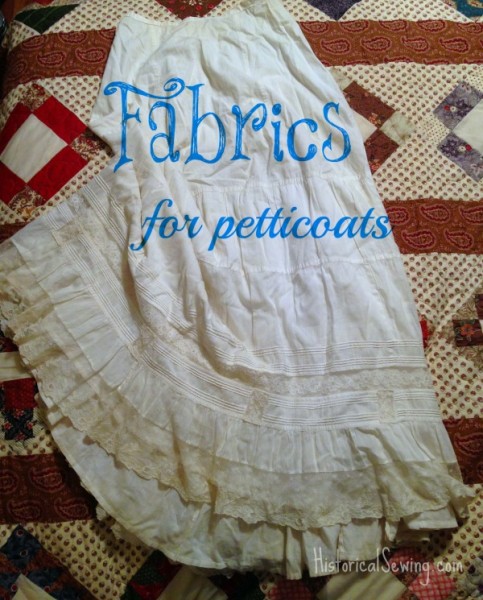
Petticoats are those undergarments that invoke romantic notions, feelings of nostalgia, and visions of swirling colors from Oklahoma!
If you’ve followed me for even a bit, you know I strongly support the wearing of petticoats. First, for historical costuming they provide much needed under-structure to support the silhouette; second, they are one of the easiest garments to make (relatively) for those just getting started in antique fashions; and third, they are just plain FUN! And frilly always brings out the delicate feminine side.
To reminisce of yesteryear’s styles, let’s go over modern day fabrics that will work well for petticoats for the historical impression or dress-up box.
For simplicity and ease of reference I’ll break this discussion down into fibers & weaves and give suggestions for what time periods they are recommended. I strongly recommend the basic, plain weave fabrics for most kinds of petticoats. Petticoats stand up to much wear & washing; make yours durable!
Also, go for lightweight materials. Don’t repeat my early mistake of making petticoats from heavy fabrics because I thought they would support the skirt better. Wrong! You merely need light petticoats – more of them. Don’t weigh down your already-substantial historical ensemble with heavy petticoats!
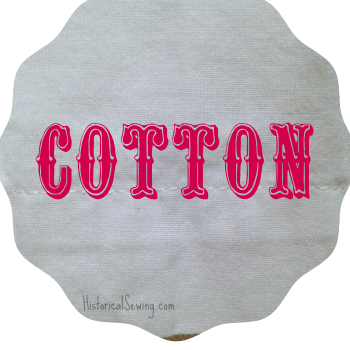
Cotton
This is perhaps THE most used textile for 19th century undergarments, petticoats especially. You’ll find cotton – plain, embroidered, embellished and starched – in petticoats from every decade cut to the shape of the skirt for best supporting that skirt. (<< silhouette tip here to keep in mind)
Use cotton for Regency bodiced petticoats, mid-century corded & quilted petticoats, ruffled versions, and plain, top-layer petticoats for all eras.
Muslin/Calico – one of the most basic cottons that can be used for nearly all petticoats. It’s an even weave in 100% cotton that varies in thickness and hand.
A word of warning here: you want the high-quality, bleached or un-bleached/natural muslin/calico sold as apparel or crafting cotton. There’s a fashion industry version of muslin that is quite stiff and used for mockups in design companies. This is NOT suitable for petticoats.
Organdy – my particular favorite for certain petticoats. An even weave fabric with a sheer or opaque appearance that’s been treated to starching/sizing for a stiff textile. Read my in-depth article on organdy because it truly is an amazing fabric.
Use organdy for 1820s to 1850s corded petticoats and smooth, single-layer-gathered-at-the-waist petticoats as a top layer under the skirt. I’ve been asked a lot about using organdy for a full ruffled petticoat… I love using organdy for ruffles for more “flouf” under the skirt with less weight. However, I recommend a plain muslin type of base fabric to which the organdy ruffles are then mounted.
Lawn – a beautiful, even weave cotton fabric that’s on the light, semi-sheer side with a slight stiffness. It’s more a dress or shirtwaist fabric but can be made up into light petticoats for summer wear. Use for mid-century through Edwardian, plain or ruffled or embroidered petticoats.
Shirtings – a delicious, even weave material that’s tightly woven for a drape-able but slightly stiff hand. Used more for dresses, shirtwaists & blouses, shirting fabric can be delightful for light petticoats that layer well. You’ll finding many shirtings in prints but look for the white or white-on-white prints & stripes for good petticoat fabric. Be watchful that you get 100% cotton and not a cotton/poly blend. Wonderful for Late Victorian and Edwardian petticoats.
Broadcloth – another great, even weave fabric for light petticoats. However, I have to caution you here as a lot of broadcloth nowadays is a cotton/polyester blend. Ugh. Sure, it’s lightweight and comes in a kazillion colors and is inexpensive. But… avoid the poly blends if you can simply because artificial fibers will hold in heat and make you feel sticky. That said, 100% cotton broadcloth can be harder to find (as “broadcloth” but is similar to quilting goods (see below)), is generally thicker and resembles more of a muslin in texture.
Quilting Cottons/Kona Cotton – I have a love/hate relationship with quilting cottons. I love them for underlinings and pretty bustle dresses. But they tend to make h.e.a.v.y. petticoats. Sure, they wash well and come in pretty prints and colors (who doesn’t want a red petticoat?!), but just be careful when you need to layer up for skirt support.
That said, I think they make up well for Regency petticoats, and also under-petticoats for mid-century and 1890s when you want a modesty layer but don’t want to use heavier flannel. Using a quilting cotton as a top petticoat layer may weigh down all your other petticoat layers and not puff up the skirt in the silhouette you are going for. Wear with a lighter petticoat on top.
Flannel – cotton (or wool) textile in a fuzzy, thick appearance that’s very good for warmth and basic under-layer petticoats throughout the century. Flannel makes up nicely in a quilted petticoat for 1830s through 1860s. Keep this petticoat fabric on the bottom with lighter petticoats on top. Leave the ruffles to some other petticoat.
Batiste – a light, opaque cotton that’s widely available in a cotton/poly blend. (You already know how I feel about that.) But for budget and value, batiste makes up into beautiful petticoats for every 19th century historical era. Get lots of yardage for making several petticoats to layer without adding a ton of weight to the overall ensemble. Works lovely for ruffled petticoats, and the 100% cotton starches very well for beautiful stiffness and silhouette support.
Sateen – cotton fabric in a satin weave. You’ll find a few hand variances so shop around. Although, the heavier the sateen (bottom-weight material), the heavier the petticoat so keep that in mind.
The sateen I bought for my Regency corded corset was light enough I could make it into an elegant Late Victorian or Edwardian petticoat. Some of the other sateen I’ve seen in local chain stores and online is simply too heavy for a petticoat. I suppose you could use it for an underpetticoat, but why waste the money on this lovely textile to only hide it?
Other cottons that are wonderful for historical projects but NOT petticoats are voile, twill, denim, chambray, netting, home dec fabrics, and polished cotton (which, I mainly recommend for underlining skirts or for hem facings and not using for a petticoat itself).
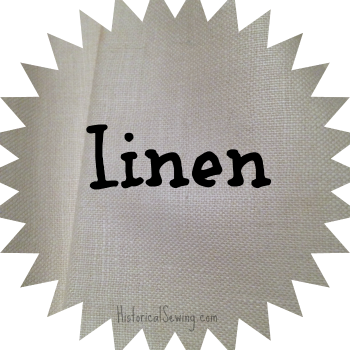
Linen
Moving on from cotton (which is good for 80% or more of your petticoats), linen has been used for petticoats for a really long time. Period correct but used more in some eras than in others.
Linen comes in basic and even weaves making it strong and flexible. Look for the tighter weaves for petticoat use so the fabric doesn’t stretch out on you too much. It’s sold in weights by ounces (per yard/meter), the lighter stuff used more appropriately for undergarments.
Cambric was originally a very tightly woven linen fabric that made up into stunning petticoats throughout the entire Victorian era. Many of the petticoats with embroidered flounces were made from cambric. Although, later in the century it was combined with cotton for fashion goods.
Cambric is a bit more difficult to find today (as named) and primarily found in cotton or a cotton/linen blend. A very high quality cotton muslin is quite similar. It starches VERY well for those papery-smooth finishes in Victorian petticoats. Similar in properties as shirting or lawn.
Other linens can be used for other under-layer petticoats such as corded or quilted or modesty. Remember to pre-wash the material a couple of times to shrink the fibers as much as possible before sewing.
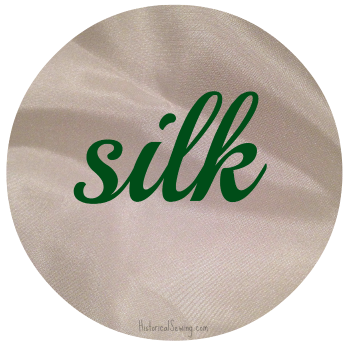
Silk
This luxurious textile was frequently used as undergarments and petticoats in the later Victorian decades and Edwardian era. Even so, the cost of today’s silks can still be prohibitive to historical costumers.
The original silk taffeta petticoats we know and love (remember Mammy’s red taffeta petticoat?) were made from a textile that was much lighter than our modern silk taffetas. Sure, you could use it to make up a petticoat that would rustle delightfully, but it would be on the thicker side, hold in heat, and at costs ranging from $15 to $28/yard aren’t necessarily best for hiding under a dress.
I will mention faux silk taffeta here because, as a costumer on a budget, it may be what you’re looking for. Lightweight and fluffy, it makes a wonderful top petticoat either plain or ruffled (just watch out for all the fraying when you sew it up and the water marks if it’s acetate rather than polyester).
China Silk – also known as habotai silk, this thin, very drape-able and soft hand textile is a nice choice for a top ruffled petticoat for Late Victorian and Edwardian petticoats. Be aware that it can snag easily though.
I’d recommend China silk more for underlinings and accessories like chemisettes and jabots rather than petticoats due to its soft hand, but for under evening gowns it’s a delight. Habotai can be rather slippery to work with. Use tissue paper underneath when cutting and sewing.
Crepe de Chine – soft, silk crepe that was used in Late Victorian petticoats and throughout the early 20th century. Another very common textile produced nowadays in polyester. Lovely petticoats that can layer well, but remember polyester will keep you warm (or hot, depending) and is not a period correct fiber.
Silk Organza – same tight weave as cotton organdy but in silk fiber. I love silk organza as an underlining! You can find it around a similar cost as organdy. For petticoats, use in the similar manner as organdy with ruffles on a cotton or silk base. Poly organza is SOOO common that you can get the same fluffy petticoat affect under Late Victorian dresses but with an immense amount of fraying until your nerves are frayed to bits. Use the silk or none at all…. Just my opinion.
Other silks: silk satin would make a wonderful 1830s to 1850s quilted petticoat but at an extreme cost. Silk twill, serge, or suiting is generally light enough for a petticoat, but again at a cost. Don’t use silk shantung with all those slubs even if the $5/yard screams your name.
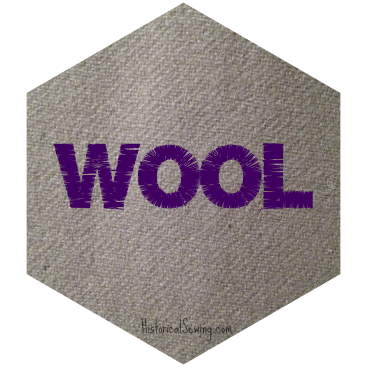
Wool
Historically, wool was used for underpetticoats for warmth or for rough work. They were more functional than decorative. They work for 1820s through Late Victorian under other cotton or linen petticoat layers. Cut in basic panels or as a quilted petticoat.
Search for wool broadcloths, summer twills or tropical weight suitings for petticoats. Wool flannel would make a very nice petticoat indeed and quite historically correct.
Happy petticoat sewing!! 🙂
What’s your favorite petticoat fabric? Have you made a petticoat from one fabric that turned out awesome? Or used a particular material that just didn’t do the job it was supposed to? Share with us in the comments below!
For more on petticoat fabric shopping, check the Fabrics & Trims Resources page.

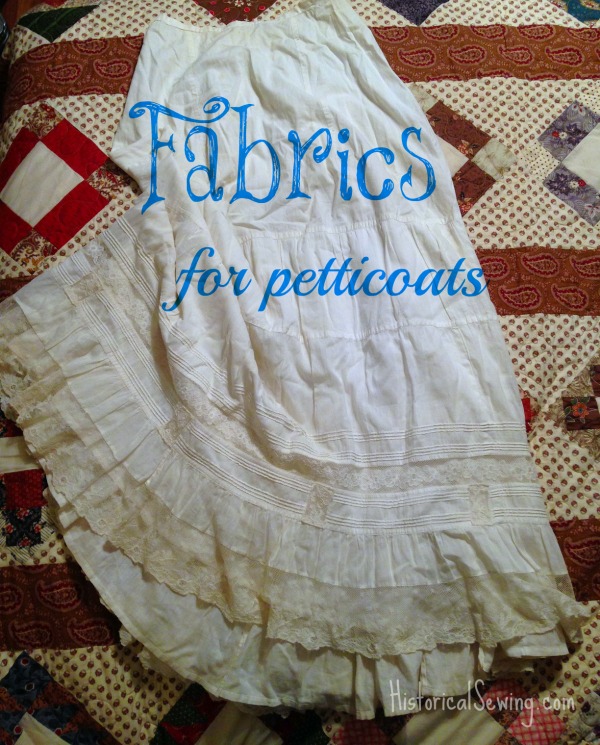
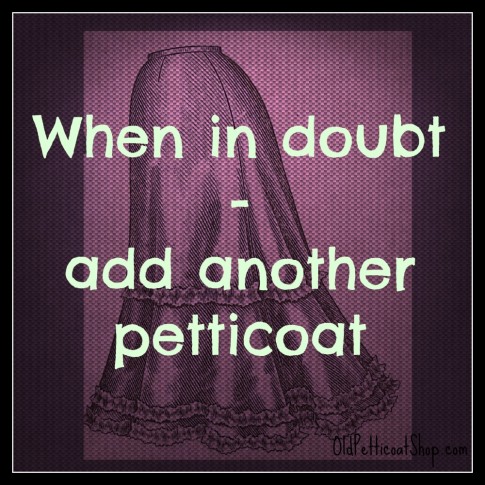
Bright red brushed cotton for the winter and white lawn for the summer. I don’t do the frilly thing beyond what is necessary as I simply can’t be bothering with the extra ironing /shudder.
May I ask a question about the practicalities of petticoats and the necessity of ruffles? To be clear, I have not yet tried my hand at a period-correct petticoat pattern, but any attempt to layer a plain long cotton skirt (quilting cotton) under similarly cut outer skirts has inevitably resulted in the quasi-petticoat climbing my legs and tying itself in jolly knots around my knees, unless I have bare legs. That being…not quite the idea…. does this happen with proper petticoats? Is it the lack the weight of a flounce or other decoration at the lower hem which causes the quasi-petticoat to climb? (I have tried it with cotton and wool stockings and various weights of modern microfibre tights with the same results…)
The key is to starch the petticoats (related post link). I recommend dip starching (fully submerged and not the spray kind) for best effect. After pressing a starched cotton petticoat a smooth, papery finish appears which helps the skirt or other petticoats, along with the undergarments, to not get “stuck” to the petticoat. Another solution would be to make the petticoat in a polished cotton, but that fabric isn’t as easy to find nowadays and the modern textile is heavier than was used in the 19th century.
Aha! Starch it is, then. Thank you! Knowing me, I’ll be trying the historical starch recipes, risks and all! I’m glad to know that ruffles are not necessary per se, unless actually required by the silhouette (they look awfully fun to make, and they look splendid on other people, but aren’t a stylistic which I personally gravitate towards very often). Polished cotton – so it is a bit of a challenge for everyone to source? – I confess, i’ve been trying and trying to find it in (continental) Europe, and haven’t had any success at all. Frustrating…. I kept thinking that I just don’t know the local terms, but perhaps it is actually not available. In any case, again, thank you so much for your very helpful answer – and, for that matter, your hugely informative website!
So glad to help you further! Yes, ruffles can be for the silhouette as well as your personal aesthetic (not everyone likes them). I’ve found home decor drapery lining to be close to polished cotton. You might check local home fabric departments for something that could be used. Be sure to pay attention to the weight; home fabrics tend to be thicker and/or heavier than apparel fabrics. Good luck going forward!
Is chintz what you call polished cotton?
Chintz IS polished cotton with a print. Other polished cotton (hard to find these days) is generally in solid colors.
what about canvas?
I dont like the feel of starch, and silk is out of my price range i thinkni can pull off the quilted petticoats but that wont do in the summer. Can canvas work?
I would not recommend canvas for petticoats. Horsehair *maybe*, but that’s rough stuff. And honestly, silk is simply fancy for a top petticoat whereas cotton and linen are truly the best in weight and support for the overall silhouette. And I’d encourage you to look again at starching cotton for petticoats. True liquid starch gives a wonderful paper finish to a petticoat that helps dirt brush off easily and keeps the petticoat at its best to support the skirts. You can read more on how to starch in this post.
I have found lovely linen tablecloths, some with scalloped hems, in thrift stores. Some were for very large tables so there was lots of yardage and with judicious cutting can yield lovely petticoats or over-skirts or even outer dresses in Regency styles. The weight of the fabric should be a guide to it’s best use.
Dear Jennifer,
I just bought the TV 22 under skirt. It wii be my first victorian project.I wanted to know if the skirt has a slight train could I bustle use a french buslte to keep the train off the ground like many wedding dresses I have seen. I think the pattern will make a nice summer skirt. I found a great 100% cotton broadcloth fabric for the petticoat and a cute cotton print for the overskirt. My plan is to make a victorian inspired modern skirt that I can wear . One other question What makes these dresses a costume and not a dress? Love this web sight so much information especially for the self taught seamstress .
Sincerely,
Lane Robson
What is the complete number and name of the pattern? That will help me answer your question.
As to your other one, that is in the eye of the beholder and what YOU think they are. A dress is still a dress no matter the time period or style. That doesn’t change. My article on the “costume-y look” might give you more insight as to how you view yours and others projects.
Sorry about the typo the pattern is TV 221 1878 tie back under skirt.
The TV221 is cut straight with no train. The back panel IS cut slightly longer than the front but is not a train length at all. The extra inch or so is to allow it to hang over the back fullness of petticoats worn underneath or with a small/thin bustle pad. It would make a very nice summer skirt too! Best of luck!!
I also use my local Goodwill and thrift stores to find petticoat fabric. Generally I can get a very nice petticoat out of a full sized flat sheet (especially if I take the time to pick out the large hem at the top) and it’s nice and soft. And the best part is you can get them for almost nothing! I have a lovely blue gray striped set that is in good enough shape I may actually make a day dress out of it! I’ve also salvaged silk velvet from an old bridesmaid’s dress which turned into a lovely collar and cuffs for a regency spencer jacket and you can also find old fur coats which make nice fur trim or muffs! The possibilities are almost endless!
I would caution from experience that wool petticoats under wool skirts can cause friction when walking, and, in dry weather, even static. Remedied with a smooth, lightweight cotton (I suggest lawn) petticoat between those wool layers. And cotton bloomers over any woolen long underthings you might be wearing. Wool-cotton layer cake!
For silk, look for “tissue taffeta”. This is a crisp, smooth fabric like very much like regular taffeta, but thinner and lighter. Often a tad cheaper too because it contains less material, but still pricey for a petticoat. And if you fall in love with a tissue taffeta and want to use it for outer layers, no worries, flat lining can give it the strength, structure and weight it lacks!
I’m trying to find if you’ve written abot how full your petticoat (bottom) flounce hem should be compared to the skirt hem. I’m Frankenpatterning a petticoat for a variation on a walking skirt that I’m upcycling. (Aiming for a 1901 “close enough” impression.) Since the original skirt doesn’t follow the gored walking skirt patterns I’ve seen (flat drop, one piece front, A-line sides; two-piece back, bias center back seam; gathered to waistband) I didn’t want to put a full Truly Victorian petticoat (which I’ve not made yet) under it. Hem width is 110″ –do I want less on the petticoat (how much less)? so the skirt floats over it? Or, more, so the flounce pushes it out more? (Or, would I end up with flounces twisting about my ankles?
Thanks!
I’ve been taught to keep the petticoats at a narrower hem width than the top skirt. It doesn’t need to be a whole lot less, and can even be the same as the skirt. You merely want to keep the skirt smooth and not look taut over the undergarments or hang weird. I think you’re on the right thought process.
I find I can get away with poly cottons if the cotton to poly ratio is 60% or better. I love petticoats and will happily layer them, but if I know I’m going to need multiples I’ll gather them into a single waistband. What I really need is a pattern for a trained (as in possessing a train–not one that knows how to fetch a stick) petticoat–or for an extension to the ones I have. Anybody got ideas?
I used the TV208 skirt pattern with the train to make a petticoat. See my post here.
Great article. I’m slurping up everything I can find on historical sewing. Have made my first bustle TV 101 and the TV 1869 Grand Parlor Skirt putting a 9″ facing for the hem. Understitched and worked great.
Now it’s time for the pettis. If more is better the lighter is better also. At least I think so. 😉
Thank you.
I use cotton, linen or a blend of the two. I do have one wool petticoat but it really doesn’t get cold enough to wear it. The others starch up very nicely.
I use old sheets from the thrift store for most of my petticoats. They are cheap, around $2 for a king, and come in 100% cotton in different weights. This works well for me since I am on a string-it-together- budget. I also cheat and use dust ruffles because I hate making ruffles. I just make an underskirt out of a heavier weight cotton sheet and it looks marvelous. It is amazing what one can cobble together, even one if is poor (unemployed, or other very restricted incomes).:-)
That seems like a really great idea, and very encouraging to people like me. I have a dream list of projects that I would like to make, and a budget that laughs at all of the beautiful clothes that I want to make. However, I refuse to let my budget stop me from dreaming about sewing, even if I have to wait a bit longer to do the actual sewing.
I can always dream about the lovely, beautiful things that I want to make, Right?
And you can always start with the cheap options available (thrift store sheets, etc) to work on your skills! 🙂
I’m sewing costumes for a high school production of Hello, Dolly! I’m determined that the girls won’t look like they are wearing made over prom dresses and curtains and bedspreads (which they are). If it drapes, I’ll put a bustle on it! I think that petticoats are the key to making these dresses look sharp. Actors who look the part perform better! We have sewn bustle pads for each girl and are now moving on to petticoats. We are making them out of old cotton sheets because that is what we have, with some ruffles and tulle here and there. Any thoughts for me about starching these petticoats? I could not find a box of clothing starch in a store so I am thinking about a washtub on the sidewalk of the school with some cornstarch and a clothes line and an ironing board. I don’t think spray starch is practical for 20+ petticoats.
Go for the store-bought liquid starch not cornstarch as it’s way too sticky. Use a medium ratio like 4:1 or heavy at 2:1 (water to starch). Yeah… spray starch is not a good solution. Good luck!
What I need now is a tutorial on how to starch. I tried it once, a looong time ago, on my husbands shirts and vowed I would never do it again. But I have so many petticoats that need that stiffness…
I agree!
Also, does starching make petticoats more wrinkle resistant? Just a thought.
Yes and no. The smooth appearance will last longer but if it’s cotton or linen they will still wrinkle just maybe not as badly depending on how thick the starch is applied.
I just another note on the disadvantage of poly/synthetic materials for petticoats: they tend to generate static. I think poly/cotton broadcloth is not so bad, but poly crepe is notorious for it! And in a long garment, such as a petti, it will stick and bind around your legs unless you have a natural fibre layer underneath.
Another really lovely cotton option for pettis I’ve now used is pillow ticking. It’s super tightly woven (to keep all those feathers in!), beautifully crisp and smooth and pretty lightweight for the thread count. It does get heavy if you use it for ruffles, but is wonderful as a base! I used it for both a petticoat and ruffled train in my recent set of Natural Form undergarments (See here). It was perfect for the petti that had just one ruffle at the hem, and for the base of the ruffled train. However, if I were to make it again I would use something lighter like lawn or organdy for the ruffles on top of the ticking base.
Just my 2 cents (or 5 cents here in Canada, since we did away with the penny, lol)